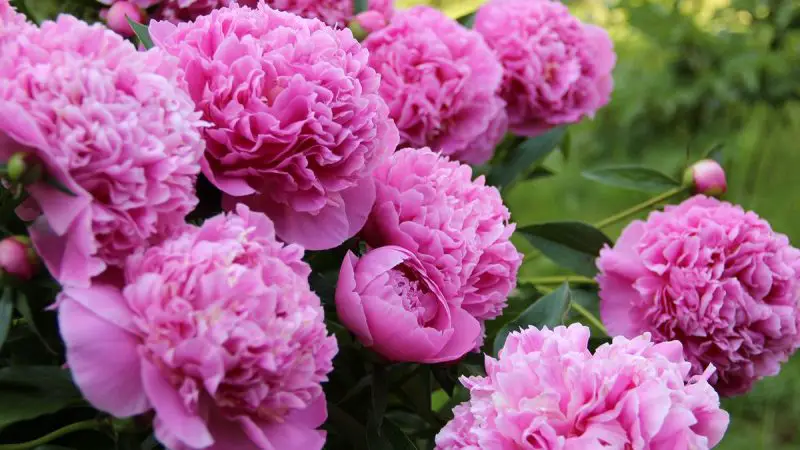Peonies are among the most cherished flowering perennials in American gardens, and for good reason. Their lush, billowy blooms, rich fragrances, and stunning variety of colors—ranging from soft pastels to bold crimsons—make them a standout feature in spring landscapes. For many gardeners, peonies aren’t just flowers; they’re sentimental favorites, passed down through generations or planted to mark special milestones. Whether grown along fences, in cutting gardens, or as foundation plants, peonies bring a timeless elegance that few other plants can match. Their blooms may only last a few weeks, but their visual and emotional impact endures long after.
To truly make the most of your peonies, understanding their seasonal rhythm is key. Peonies don’t all bloom at once—different varieties flower at different times, from late spring to early summer, depending on your region and local climate. Factors such as soil temperature, sunlight exposure, and winter chill all influence bloom timing. This comprehensive guide will walk you through the typical blooming windows for peonies in each USDA hardiness zone, how to extend the blooming season with variety selection, and best practices to encourage healthy, vibrant flowers. Whether you’re a new gardener or a seasoned peony lover, this information will help you plan, grow, and enjoy these beloved blooms year after year.
The Peony Bloom Cycle Explained

What Determines Peony Blooming Time
Peonies follow a seasonal growth cycle heavily influenced by winter chilling and spring warming. The key factor for blooming is vernalization, the process through which peonies require a certain number of cold days to break dormancy and develop flower buds. Without sufficient chill hours, peonies may produce lush foliage but fail to bloom.
Once temperatures begin to warm in spring, peonies emerge from the soil as reddish shoots. These shoots develop into leafy stems, and flower buds soon follow. Blooming typically begins in late spring, but the exact timing can vary depending on variety, climate, and care.
Stages of Growth Leading to Bloom
The peony growth cycle begins in late winter to early spring, when underground tuberous roots awaken. As soil temperatures rise, buds begin to swell and shoots break through the surface. In the following weeks, foliage expands, stems elongate, and flower buds become more prominent. Blooming lasts about one to two weeks per plant. After blooming, peonies enter the foliage phase, storing energy for the next growing season.
When Do Peonies Bloom by Region
Southern United States
In warmer regions like Georgia, Alabama, and parts of Texas, peonies typically bloom as early as mid to late April. The mild winters provide sufficient chill hours for early bloomers, and spring arrives quickly. Gardeners in these areas can often grow herbaceous peonies and some intersectional (Itoh) hybrids successfully.
Midwestern United States
States like Illinois, Ohio, and Iowa see peony blooms between mid-May and early June. The Midwest offers an ideal climate for peonies, with cold winters and mild, gradually warming springs. The peony bloom season here can last four to five weeks when multiple varieties are planted.
Northeastern United States
In New York, Massachusetts, and Pennsylvania, peonies bloom from late May into early June. These regions provide excellent winter chill and reliable spring moisture, making them prime peony-growing zones. Cooler springs may delay blooming slightly, but flowers tend to last longer.
Pacific Northwest
Oregon and Washington have unique climates for peonies. With cool, wet springs and mild summers, peonies may bloom from late May into early June. Gardeners in these areas should ensure good drainage to prevent root rot during the rainy season.
Mountain and High Desert Regions
In areas like Colorado, Utah, and northern Nevada, peonies bloom in late May or early June. The high elevation provides cold winters, but spring frosts can sometimes damage early growth. Mulching and wind protection help ensure successful blooming in these regions.
Peony Types and Their Blooming Windows
Early-Season Bloomers
Some varieties are known to bloom earlier in the season, such as ‘Coral Charm’, ‘Early Scout’, and ‘Roselette’. These peonies typically flower in late April to early May in milder climates. Early bloomers are ideal for regions where spring warms quickly.
Midseason Bloomers
Popular midseason varieties include ‘Sarah Bernhardt’, ‘Festiva Maxima’, and ‘Kansas’. These bloom from mid-May through early June in most areas. Midseason peonies are the most commonly planted due to their wide adaptability and stunning floral forms.
Late-Season Bloomers
Late bloomers like ‘Bowl of Beauty’ and ‘Karl Rosenfield’ extend the peony show into mid-June. These are especially valuable in northern climates, where cooler temperatures slow the growth cycle. Combining peonies from all bloom periods ensures continuous flowering for four to six weeks.
Factors That Affect Bloom Time
Climate and Microclimates
Your regional climate is the biggest determinant of bloom timing, but microclimates within your yard also play a role. A sunny, south-facing wall warms faster in spring, causing nearby peonies to bloom earlier than those in shaded or exposed areas.
Planting Depth
Planting peonies too deep is a common mistake that delays or prevents blooming. The eyes, or buds, should be no more than one to two inches below the soil surface. Deeper planting reduces the plant’s ability to sense seasonal temperature changes.
Plant Age and Establishment
Peonies take time to settle into their environment. Newly planted peonies may not bloom during the first year and may produce limited flowers in the second. A mature peony, three to five years old, is more likely to bloom reliably and prolifically.
Variety and Genetics
Some varieties are naturally more vigorous or quicker to bloom. Intersectional hybrids, for example, often flower more consistently and have sturdier stems than traditional herbaceous types. Tree peonies can bloom slightly earlier and often have larger, showier blossoms.
Tips for Encouraging Longer Bloom Periods
Planting a Mix of Varieties
To maximize the peony bloom season in your garden, consider selecting a well-curated mix of early, midseason, and late-blooming cultivars. Peonies naturally bloom for a relatively short period—typically 7 to 10 days per plant—but staggering bloom times across varieties can extend the overall display to five or even six weeks. For example, ‘Red Charm’ is a popular early bloomer, while ‘Sarah Bernhardt’ tends to flower in midseason, and ‘Bowl of Beauty’ or ‘Felix Crousse’ often bloom late in the cycle. This intentional layering of timing allows gardeners to enjoy an evolving color palette and texture over an extended period.
When planning your mix, consider not only bloom timing but also plant height, fragrance, and resistance to weather damage. Taller, late-season peonies may benefit from staking, while compact early types are often more resistant to wind and rain.
Proper Fertilization
Feeding peonies correctly plays a crucial role in both the quality and duration of their blooms. In early spring, as red shoots start to emerge, apply a balanced fertilizer such as 10-10-10 or 5-10-10. A lower nitrogen ratio is essential—too much nitrogen encourages vigorous leaf and stem growth but suppresses flower bud formation. For best results, work the fertilizer gently into the soil around the drip line rather than directly on the crown, and water thoroughly afterward to help nutrients reach the roots.
A supplemental feeding right after flowering—lighter and focused on potassium and phosphorus—can help rebuild energy reserves in the roots and support future blooming. Avoid over-fertilizing, especially with nitrogen-heavy lawn products, which can result in green, bushy plants with few or no flowers the following season.
Sunlight and Location
Sun exposure directly impacts the bloom performance of peonies. They thrive best in full sun, defined as a minimum of six hours of direct sunlight daily. Morning sun is especially valuable because it helps dry dew on the foliage and buds, reducing the risk of fungal diseases such as botrytis. While peonies can tolerate light afternoon shade in hotter climates, too much shade can significantly reduce bud production and delay flowering by several days or even weeks.
Good air circulation around the plant is also essential. Avoid planting peonies too close to fences, walls, or other perennials that could block sunlight or trap humidity. Raised beds or gently sloping ground can improve drainage and airflow, leading to healthier plants and more reliable blooming.
Deadheading and Foliage Care
Once flowers begin to fade, deadheading is an important maintenance task that helps redirect the plant’s energy away from seed production and back into root and bud development. To deadhead properly, snip the spent flower stem just above the first strong set of leaves. This not only improves plant appearance but also reduces the chance of fungal infection from rotting petals.
After blooming ends, the foliage should be left intact throughout summer and early fall. The leaves continue photosynthesis, storing carbohydrates in the roots to fuel next spring’s growth. Cutting back too early—before the leaves naturally yellow and die back—can weaken the plant and reduce future bloom quantity. Regularly inspect foliage for signs of powdery mildew or botrytis, particularly in humid climates. If necessary, thin the stems to increase air circulation or apply an organic fungicide as a preventive measure.
Common Blooming Issues and How to Solve Them
Peonies Not Blooming: Causes and Targeted Fixes
One of the most frustrating experiences for gardeners is a mature peony plant that refuses to bloom. There are several underlying reasons, and each requires a specific solution.
A common cause is planting depth. Peonies must be planted with their eyes (the reddish buds at the root crown) no deeper than 1 to 2 inches below the soil surface. Planting too deep can suppress flowering for years. To correct this, carefully lift and replant the crown at the proper depth in early fall.
Age also matters. Newly planted peonies may take two to three years to bloom reliably. Patience, along with consistent care, usually pays off.
Light availability is another key factor. Peonies require at least six hours of full sun daily to produce blooms. In shadier sites, consider transplanting them to a sunnier location in the fall.
Nutrient imbalance, particularly excess nitrogen, can result in lush foliage at the expense of blooms. Use a fertilizer low in nitrogen and higher in phosphorus and potassium—something like 5-10-10. Avoid fertilizing too early or too often.
In colder climates, late spring frosts can damage buds before they open. Protect developing shoots with light covers (like frost cloth) during cold snaps.
Lastly, overcrowding may lead to poor air circulation and reduced blooming. If your peony has been in the same spot for over ten years, consider lifting, dividing, and replanting it in early fall to rejuvenate its vigor.
Bud Blast: Understanding and Managing This Silent Bloom Killer
Bud blast occurs when flower buds begin forming but shrivel, turn brown, and never open. This issue often goes unnoticed until too late in the season.
A major culprit is inconsistent watering, especially during bud formation in late spring. Dry spells followed by heavy rain can stress the plant. To prevent this, maintain consistent soil moisture—neither waterlogged nor bone dry.
Nutritional deficiencies, especially in potassium and phosphorus, can weaken bud development. Apply a slow-release balanced fertilizer early in the growing season and again lightly in midsummer if needed.
Fungal infections, such as botrytis blight, can invade buds and cause them to rot from within. This often happens in humid or poorly ventilated areas. Remove and dispose of any affected buds immediately, and clean up fallen debris around the plant to reduce spore buildup. Consider applying a fungicide labeled for ornamental plants during wet spring weather if the problem persists year after year.
Temperature fluctuations, such as a warm spell followed by sudden cold, can also lead to bud failure. While you can’t control the weather, choosing a planting site with good air circulation and stable microclimate—away from walls that radiate heat—can help.
Finally, root stress from transplanting, crowding, or poor drainage can hinder bloom development. Ensure soil is loose, well-drained, and rich in organic matter to encourage healthy roots and strong bud production.
Weak or Drooping Stems: Prevention and Support Strategies
Peonies are known for their showy, heavy blooms, but those same flowers often weigh down their stems—especially after rain or in windy conditions.
The most effective solution is early support. Install a peony ring or circular support system in early spring as shoots emerge. If added too late, stems may already be bent and difficult to train. Gardeners in wetter climates may need to combine rings with discreet bamboo stakes for additional vertical support.
Soil health directly affects stem strength. Ensure your soil is well-drained and amended with compost or aged manure to provide strong root anchorage and steady nutrient uptake.
Mulching around the base of the plant (but not directly over the crown) retains moisture and prevents dramatic shifts in soil temperature that can weaken root systems. Use organic mulch like shredded bark or composted leaves to also improve long-term soil structure.
Prune wisely in fall to remove all stems at ground level after they naturally yellow and die back. This reduces the chance of fungal disease overwintering and strengthens next year’s stem growth.
If drooping is extreme, consider variety selection in the future. Some peony types, especially herbaceous hybrids, have stronger stems than traditional double-flowered varieties, which tend to be top-heavy. Choosing cultivars like ‘Coral Charm’ or ‘Festiva Maxima’ can result in sturdier garden displays with less need for intervention.
Seasonal Maintenance Schedule
Fall Preparation: Setting the Stage for Next Year’s Blooms
Autumn is a critical time for peony maintenance. As the blooming season ends and foliage naturally turns yellow or brown, it signals that the plant is preparing for dormancy. At this point, allow the foliage to die back completely before cutting stems down to soil level. Cutting too early can reduce the plant’s ability to store energy in the roots for the following year.
Remove and discard all plant debris to prevent overwintering diseases such as botrytis blight or powdery mildew. Do not compost these materials, as fungal spores can survive and reinfect your garden.
In colder regions, where hard freezes are common, apply a 2 to 4-inch layer of organic mulch such as straw, shredded leaves, or compost over the root zone. This helps insulate the crown against extreme temperature fluctuations. However, avoid covering the crown itself, as excess moisture trapped beneath thick mulch can encourage rot.
Fall is also a good time to divide and transplant peonies if needed. Doing so while the plant is dormant reduces stress and allows roots to establish before the next growing season.
Winter Dormancy: Rest and Protection
Peonies rely on a cold winter rest to initiate flower bud development. Most varieties require a chilling period of at least 400 to 700 hours below 40°F (4°C) to bloom properly. This natural dormancy period is crucial, and gardeners should avoid disturbing the soil or crown during this time.
In snowy regions, snow cover acts as an excellent natural insulator, keeping soil temperatures stable and protecting peony roots from freeze-thaw cycles. In areas with little snowfall but frequent freezing temperatures, supplemental mulch or frost blankets may be necessary.
It’s also important that the planting site has excellent drainage. Waterlogged soil during winter can lead to crown rot and root suffocation. Avoid covering the crown with heavy, dense mulch or compacted leaves, which can trap moisture and delay the plant’s emergence in spring.
Resist the urge to water during winter unless the season is unusually dry and the soil has completely thawed. Overwatering dormant roots can create fungal issues.
Spring Activation: Wake-Up Time and Early Growth
As the weather warms and soil temperatures rise, typically between late March and early May depending on the region, peonies begin to emerge from dormancy. Remove any mulch gently from around the crown to prevent suffocating young shoots, often called “eyes,” which are pink or reddish in color.
This is the ideal time to begin fertilizing. Use a balanced, slow-release fertilizer (such as 10-10-10) once shoots are 2–3 inches tall. Avoid over-fertilizing with nitrogen, as it can lead to lush foliage at the expense of blooms. Organic options like composted manure or bone meal can also enhance soil health and support strong flowering.
Early spring is also when pests and diseases begin to emerge. Watch for signs of:
Thrips, which can damage buds and cause deformed blooms. Insecticidal soap or neem oil can be effective.
Fungal diseases, such as leaf blotch or botrytis, which appear as dark spots or fuzzy mold on new shoots. Good air circulation, proper spacing, and clean pruning practices reduce risk.
Ants, commonly found on peony buds, are typically harmless and attracted to nectar—not a threat to the plant itself.
Support structures like grow-through rings or stakes can be added in early spring before the plant becomes too tall. This helps prevent flopping under the weight of heavy blooms, especially after rain.
As buds form, ensure the plant gets at least 6 hours of direct sun each day. Inadequate light may reduce flower size and count. Water deeply but infrequently to encourage deep root growth, especially during dry spring spells.
Peonies in Cut Flower Arrangements
Best Time to Harvest for Maximum Beauty
Peonies are treasured not only in the garden but also in floral arrangements for their lush, romantic blooms and long-lasting fragrance. To capture their full potential as cut flowers, timing the harvest is critical. The ideal moment to cut peonies is during the “soft bud” stage—when the bud feels like a firm marshmallow when gently squeezed but hasn’t yet begun to open. At this phase, the flower has developed enough to bloom fully indoors but remains tight enough to ensure the longest vase life.
Harvesting too early may result in buds that never open, while cutting them too late—after the petals begin to loosen—can cause blooms to wilt prematurely in the vase. Morning is the best time to harvest, as temperatures are cooler and the plant is well-hydrated. Always use sharp, clean pruning shears to avoid crushing stems and to reduce the risk of introducing bacteria that could shorten the vase life.
If you’re cutting multiple stems for an arrangement, be sure not to remove more than a third of the plant’s foliage. Peonies need their leaves intact after blooming to continue photosynthesis and store energy for next year’s flowers.
Extending Vase Life with Proven Techniques
Peonies can last 5 to 10 days in a vase with proper care. Begin by trimming each stem at a 45-degree angle under lukewarm water to increase water uptake. Strip away any leaves that will sit below the waterline, as submerged foliage promotes bacterial growth that can clog the stems and cause flowers to fade quickly.
Place the trimmed stems in a clean vase filled with cool, fresh water. It’s beneficial to use a floral preservative, which contains sugar to nourish the flower and antimicrobial agents to keep water clean. If you don’t have preservative, a DIY mix of one teaspoon of sugar, one teaspoon of white vinegar, and a few drops of bleach in a quart of water can help extend freshness.
To keep your arrangement vibrant, change the water daily and retrim the stems slightly every other day. Avoid placing vases in direct sunlight, near heating vents, or in drafty areas. Peonies are sensitive to heat and light and will fade more quickly under harsh conditions.
For an extended display, you can also refrigerate uncut stems. Wrap the stems in damp paper towels, place them in a sealed plastic bag, and store them in the fridge for up to one week. When ready to use, recut the stems and place them in water—this trick is especially useful for timing peony displays for events like weddings or holidays.
Another helpful tip is to combine peonies with complementary flowers that offer structure and contrast. Flowers like snapdragons, delphiniums, and lisianthus pair beautifully with peonies and extend the visual interest of an arrangement. Incorporating foliage such as eucalyptus or ferns can add depth and texture, further elevating the bouquet.
Bonus Tips from Florists
Many professional florists recommend conditioning peony stems by placing them in a bucket of warm water for a few hours before arranging. This allows the blooms to hydrate deeply and open evenly. If you need to speed up blooming for an event, placing buds in a warm room with indirect light can encourage them to open faster. Conversely, storing arrangements in a cool location at night can slow down the blooming process and keep the flowers fresh for longer.
Whether you’re cutting a single stem to enjoy on your kitchen table or creating a show-stopping bouquet for a special occasion, peonies offer timeless elegance. With proper harvesting and care, they can provide stunning beauty and fragrance long after they leave the garden.
FAQ About Peony Blooming
When is the best time of year to plant peonies?
The ideal time to plant peonies is in the fall, typically from late September through October. This allows roots to establish before winter and ensures healthy growth and blooming in spring. Spring planting is possible, but the plants may take longer to flower.
Why didn’t my peonies bloom this year?
Lack of blooms can result from several factors: planting too deep, insufficient sunlight, poor soil drainage, immature plants, or overuse of nitrogen-rich fertilizer. Late frost and bud blast may also prevent flowers from forming. Evaluate these conditions and adjust care accordingly.
Can I grow peonies in warm climates like Florida?
Peonies require winter chill hours to bloom, so growing them in USDA zones 9 and above is challenging. However, gardeners in slightly warmer zones can try early-blooming varieties or Itoh hybrids. Container planting and artificial chilling can also help simulate required cold exposure.
How long do peony flowers last once they bloom?
Individual peony blooms usually last between 7 to 10 days. By planting early, midseason, and late-blooming varieties, you can enjoy continuous blooms in your garden for up to six weeks. Cut peonies at the marshmallow bud stage for longer-lasting vase life indoors.
Should I deadhead peonies after they bloom?
Yes, removing spent flowers helps the plant focus energy on root development instead of seed production. However, you should leave the foliage intact throughout the growing season to allow for photosynthesis and energy storage for the following year’s bloom.
Final Thoughts on Peony Blooming
Knowing when peonies bloom—and how to encourage those blooms—is key to a vibrant spring garden. From early-blooming varieties in southern climates to late bloomers in northern regions, peonies offer color, fragrance, and charm that few other plants can match. With thoughtful planting, proper care, and seasonal maintenance, you can enjoy these show-stopping flowers year after year.
Whether you’re starting your first peony patch or looking to improve the bloom performance of existing plants, understanding seasonal timing and growing techniques will help you achieve the best results. Timing is everything when it comes to peonies, and a little planning goes a long way toward a breathtaking garden.






